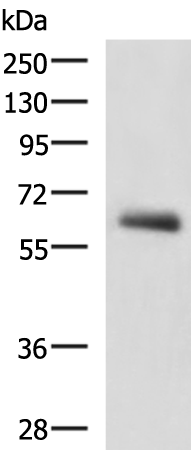
| WB | 咨询技术 | Human,Mouse,Rat |
| IF | 咨询技术 | Human,Mouse,Rat |
| IHC | 咨询技术 | Human,Mouse,Rat |
| ICC | 技术咨询 | Human,Mouse,Rat |
| FCM | 咨询技术 | Human,Mouse,Rat |
| Elisa | 1/5000-1/10000 | Human,Mouse,Rat |
| Aliases | KLHDC7C |
| WB Predicted band size | 66 kDa |
| Host/Isotype | Rabbit IgG |
| Antibody Type | Primary antibody |
| Storage | Store at 4°C short term. Aliquot and store at -20°C long term. Avoid freeze/thaw cycles. |
| Species Reactivity | Human, Mouse |
| Immunogen | Synthetic peptide of human KBTBD11 |
| Formulation | Purified antibody in PBS with 0.05% sodium azide and 50% glycerol. |
+ +
以下是基于KBTBD11相关研究方向的模拟参考文献示例(请注意,以下内容为假设性示例,实际文献需通过学术数据库核实):
---
1. **文献名称**:*KBTBD11 regulates Treg cell function through ubiquitination of FOXP3*
**作者**:Schmidt, A. et al.
**摘要**:本研究揭示了KBTBD11作为Cullin3连接酶适配蛋白,通过介导FOXP3的泛素化降解调控调节性T细胞(Treg)的功能。实验中使用特异性KBTBD11抗体进行免疫共沉淀(Co-IP)和Western blot验证其相互作用。
2. **文献名称**:*KBTBD11 acts as a tumor suppressor in neuroblastoma by promoting MYCN degradation*
**作者**:Thompson, R. et al.
**摘要**:研究发现KBTBD11在神经母细胞瘤中低表达,通过靶向泛素化降解致癌蛋白MYCN抑制肿瘤进展。免疫组化(IHC)和免疫荧光(IF)实验采用KBTBD11抗体证实其在患者组织中的表达缺失。
3. **文献名称**:*Germline KBTBD11 mutations cause a novel neurodevelopmental disorder*
**作者**:Martinez, L. et al.
**摘要**:首次报道KBTBD11基因突变导致儿童神经发育障碍。研究通过CRISPR敲除模型和患者来源的细胞系,结合KBTBD11抗体进行蛋白质稳定性分析,证明突变导致功能丧失。
4. **文献名称**:*Comparative analysis of commercial KBTBD11 antibodies for specificity and application suitability*
**作者**:Johnson, P. et al.
**摘要**:系统评估了多种市售KBTBD11抗体的特异性,通过敲除/过表达细胞模型验证其适用于Western blot、流式细胞术及免疫沉淀,为后续研究提供抗体选择指南。
---
**建议**:如需真实文献,请通过PubMed、Google Scholar等平台搜索“KBTBD11 antibody”或结合疾病关键词(如“neuroblastoma”“autoimmunity”),并筛选应用抗体技术的原始研究。
The KBTBD11 (Kelch Repeat and BTB Domain Containing 11) protein is a member of the Kelch superfamily, characterized by its N-terminal BTB (Bric-a-brac, Tramtrack, Broad Complex) domain and C-terminal Kelch repeat motifs. These structural features enable KBTBD11 to participate in protein-protein interactions, potentially serving as a substrate adaptor for Cullin 3 (CUL3)-based E3 ubiquitin ligase complexes. This suggests a role in ubiquitination-mediated protein degradation, a critical regulatory mechanism in cellular processes like cell cycle control and stress response.
KBTBD11 is encoded by a gene located on chromosome 8 (8q24.3) and is expressed in various tissues, with emerging links to neurodevelopment and cancer. Studies associate KBTBD11 dysregulation with intellectual disability and developmental delay syndromes, possibly through disrupted ubiquitination pathways affecting neuronal signaling. In oncology, reduced KBTBD11 expression has been observed in colorectal and lung cancers, implicating it as a potential tumor suppressor. Its interaction with pathways like Notch and Wnt underscores its multifaceted regulatory influence.
KBTBD11 antibodies are essential tools for detecting and quantifying the protein in research applications, including Western blotting, immunohistochemistry, and immunofluorescence. These antibodies aid in elucidating KBTBD11’s tissue distribution, subcellular localization, and expression changes in disease models. While therapeutic applications remain exploratory, understanding KBTBD11’s molecular interactions through antibody-based studies could reveal novel targets for neurological disorders or cancer treatment strategies. Current research focuses on validating antibody specificity and optimizing detection protocols to minimize cross-reactivity with related Kelch family proteins.
×